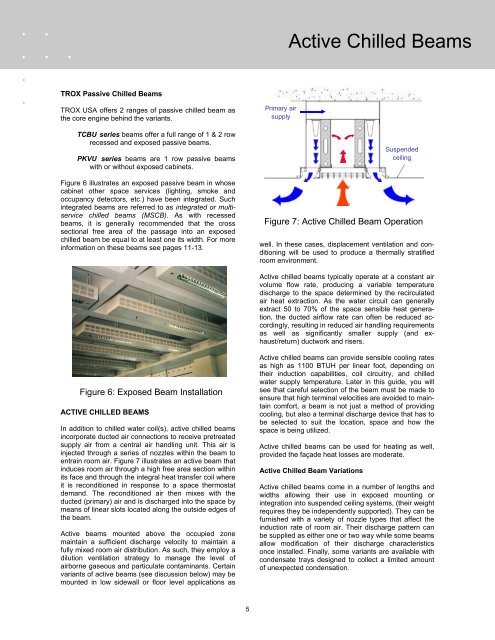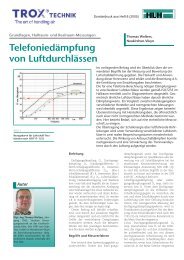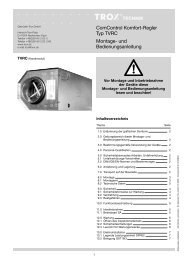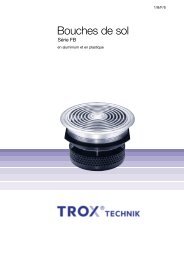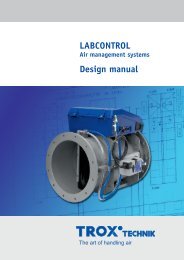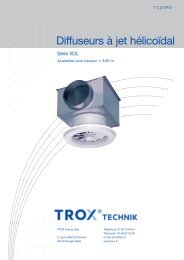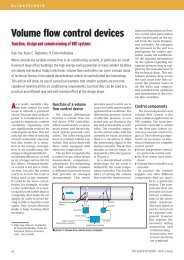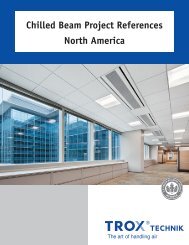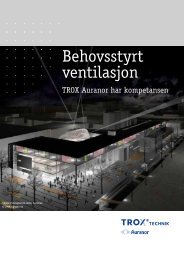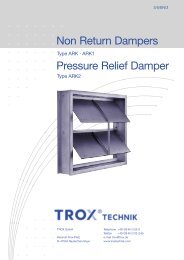Create successful ePaper yourself
Turn your PDF publications into a flip-book with our unique Google optimized e-Paper software.
Active <strong>Chilled</strong> <strong>Beam</strong>s<br />
<strong>TROX</strong> Passive <strong>Chilled</strong> <strong>Beam</strong>s<br />
<strong>TROX</strong> USA offers 2 ranges of passive chilled beam as<br />
the core engine behind the variants.<br />
Primary air<br />
supply<br />
TCBU series beams offer a full range of 1 & 2 row<br />
recessed and exposed passive beams.<br />
PKVU series beams are 1 row passive beams<br />
with or without exposed cabinets.<br />
Figure 6 illustrates an exposed passive beam in whose<br />
cabinet other space services (lighting, smoke and<br />
occupancy detectors, etc.) have been integrated. Such<br />
integrated beams are referred to as integrated or multiservice<br />
chilled beams (MSCB). As with recessed<br />
beams, it is generally recommended that the cross<br />
sectional free area of the passage into an exposed<br />
chilled beam be equal to at least one its width. For more<br />
information on these beams see pages 11-13.<br />
Suspended<br />
ceiling<br />
Figure 7: Active <strong>Chilled</strong> <strong>Beam</strong> Operation<br />
well. In these cases, displacement ventilation and conditioning<br />
will be used to produce a thermally stratified<br />
room environment.<br />
Active chilled beams typically operate at a constant air<br />
volume flow rate, producing a variable temperature<br />
discharge to the space determined by the recirculated<br />
air heat extraction. As the water circuit can generally<br />
extract 50 to 70% of the space sensible heat generation,<br />
the ducted airflow rate can often be reduced accordingly,<br />
resulting in reduced air handling requirements<br />
as well as significantly smaller supply (and exhaust/return)<br />
ductwork and risers.<br />
Figure 6: Exposed <strong>Beam</strong> Installation<br />
ACTIVE CHILLED BEAMS<br />
In addition to chilled water coil(s), active chilled beams<br />
incorporate ducted air connections to receive pretreated<br />
supply air from a central air handling unit. This air is<br />
injected through a series of nozzles within the beam to<br />
entrain room air. Figure 7 illustrates an active beam that<br />
induces room air through a high free area section within<br />
its face and through the integral heat transfer coil where<br />
it is reconditioned in response to a space thermostat<br />
demand. The reconditioned air then mixes with the<br />
ducted (primary) air and is discharged into the space by<br />
means of linear slots located along the outside edges of<br />
the beam.<br />
Active beams mounted above the occupied zone<br />
maintain a sufficient discharge velocity to maintain a<br />
fully mixed room air distribution. As such, they employ a<br />
dilution ventilation strategy to manage the level of<br />
airborne gaseous and particulate contaminants. Certain<br />
variants of active beams (see discussion below) may be<br />
mounted in low sidewall or floor level applications as<br />
Active chilled beams can provide sensible cooling rates<br />
as high as 1100 BTUH per linear foot, depending on<br />
their induction capabilities, coil circuitry, and chilled<br />
water supply temperature. Later in this guide, you will<br />
see that careful selection of the beam must be made to<br />
ensure that high terminal velocities are avoided to maintain<br />
comfort, a beam is not just a method of providing<br />
cooling, but also a terminal discharge device that has to<br />
be selected to suit the location, space and how the<br />
space is being utilized.<br />
Active chilled beams can be used for heating as well,<br />
provided the façade heat losses are moderate.<br />
Active <strong>Chilled</strong> <strong>Beam</strong> Variations<br />
Active chilled beams come in a number of lengths and<br />
widths allowing their use in exposed mounting or<br />
integration into suspended ceiling systems, (their weight<br />
requires they be independently supported). They can be<br />
furnished with a variety of nozzle types that affect the<br />
induction rate of room air. Their discharge pattern can<br />
be supplied as either one or two way while some beams<br />
allow modification of their discharge characteristics<br />
once installed. Finally, some variants are available with<br />
condensate trays designed to collect a limited amount<br />
of unexpected condensation.<br />
5


